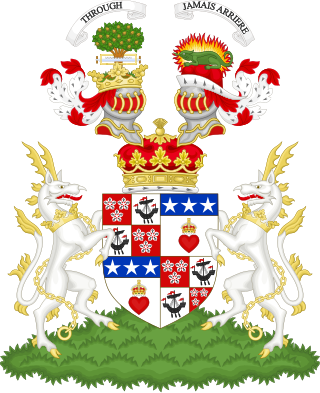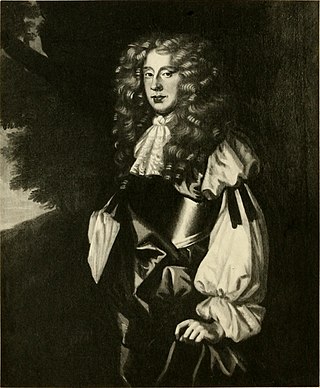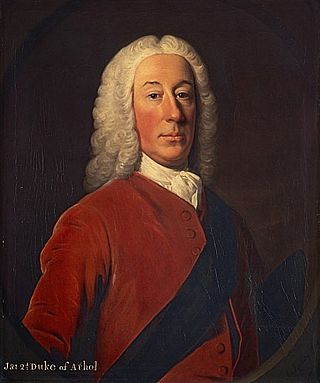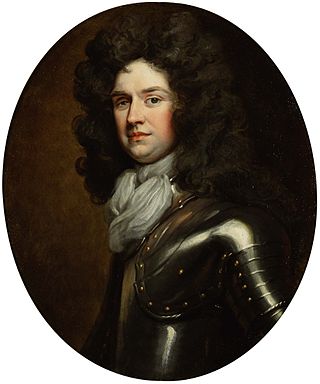| |||||
| Centuries: | |||||
|---|---|---|---|---|---|
| Decades: | |||||
| See also: | List of years in Scotland Timeline of Scottish history 1703 in: England • Wales • Elsewhere | ||||
Events from the year 1703 in the Kingdom of Scotland .
| |||||
| Centuries: | |||||
|---|---|---|---|---|---|
| Decades: | |||||
| See also: | List of years in Scotland Timeline of Scottish history 1703 in: England • Wales • Elsewhere | ||||
Events from the year 1703 in the Kingdom of Scotland .

Duke of Hamilton is a title in the Peerage of Scotland, created in April 1643. It is the senior dukedom in that peerage, and as such its holder is the premier peer of Scotland, as well as being head of both the House of Hamilton and the House of Douglas. The title, the town of Hamilton in Lanarkshire, and many places around the world are named after members of the Hamilton family. The ducal family's surname, originally "Hamilton", is now "Douglas-Hamilton". Since 1711, the dukedom has been held together with the Dukedom of Brandon in the Peerage of Great Britain, and the dukes since that time have been styled Duke of Hamilton and Brandon, along with several other subsidiary titles.

Duke of Atholl, named after Atholl in Scotland, is a title in the Peerage of Scotland held by the head of Clan Murray. It was created by Queen Anne in 1703 for John Murray, 2nd Marquess of Atholl, with a special remainder to the heir male of his father, the 1st Marquess.

The Most Ancient and Most Noble Order of the Thistle is an order of chivalry associated with Scotland. The current version of the order was founded in 1687 by King James VII of Scotland, who asserted that he was reviving an earlier order. The order consists of the sovereign and sixteen knights and ladies, as well as certain "extra" knights. The sovereign alone grants membership of the order; they are not advised by the government, as occurs with most other orders.

Atholl or Athole is a district in the heart of the Scottish Highlands, bordering Marr, Gowrie, Perth, Strathearn, Breadalbane, Lochaber, and Badenoch. Historically it was a Pictish kingdom, becoming one of the original provinces of the Kingdom of Alba before being incorporated into the sheriffdom and later county of Perthshire. Today it forms the northern part of Perth and Kinross, Scotland.

Marquess of Linlithgow, in the County of Linlithgow or West Lothian, is a title in the Peerage of the United Kingdom. It was created on 23 October 1902 for John Hope, 7th Earl of Hopetoun. The current holder of the title is Adrian Hope.

Earl of Cromartie is a title that has been created twice, both for members of the Mackenzie family. It was first created as Earl of Cromarty in the Peerage of Scotland in 1703 for Sir George Mackenzie, 2nd Baronet, but his titles were forfeited after the Jacobite rising of 1745. It was recreated in 1861 in the Peerage of the United Kingdom for Anne Sutherland-Leveson-Gower, Duchess of Sutherland. Since 1979, the Earl of Cromartie has been chief of Clan Mackenzie.

John Murray, 1st Duke of Atholl,, was a Scottish nobleman, politician, and officee. He served in numerous positions during his life, and fought in the Glorious Revolution for William III and Mary II.

James Drummond, 4th Earl of Perth, KT, PC was a Scottish peer and politician.

James Douglas, 2nd Duke of Queensberry and 1st Duke of Dover was a Scottish nobleman and a leading politician of the late 17th and the early 18th centuries. As Lord High Commissioner he was instrumental in negotiating and passing the Acts of Union 1707 with England, which created the Kingdom of Great Britain.

John Murray, 1st Marquess of Atholl, KT was a leading Scottish royalist and defender of the Stuarts during the English Civil War of the 1640s, until after the rise to power of William and Mary in 1689. He succeeded as 2nd Earl of Atholl on his father's demise in June 1642 and as 3rd Earl of Tullibardine after the death of his first cousin the 2nd Earl in 1670.

James Murray, 2nd Duke of Atholl,, styled Marquess of Tullibardine between 1715 and 1746, was the Lord of Mann, a Scottish peer, and Lord Privy Seal.

Clan Murray is a Highland Scottish clan. The chief of the Clan Murray holds the title of Duke of Atholl. Their ancestors were the Morays of Bothwell who established the family in Scotland in the 12th century. In the 16th century, descendants of the Morays of Bothwell, the Murrays of Tullibardine, secured the chiefship of the clan and were created Earls of Tullibardine in 1606. The first Earl of Tullibardine married the heiress to the Stewart earldom of Atholl and Atholl therefore became a Murray earldom in 1626. The Murray Earl of Atholl was created Marquess of Atholl in 1676 and in 1703 it became a dukedom. The marquess of Tullibardine title has continued as a subsidiary title, being bestowed on elder sons of the chief until they succeed him as Duke of Atholl.
Charles Hope, 1st Earl of Hopetoun, KT, PC was a Scottish nobleman.

The Lord High Commissioner to the General Assembly of the Church of Scotland is the monarch's personal representative to the General Assembly of the Church of Scotland, reflecting the Church's role as the national church of Scotland and the monarch's role as protector and member of that Church. In its history, the office holder has been the personal representatives to all Scottish monarchs, and later British monarchs, following the Union of the Crowns.

General David Colyear, 1st Earl of Portmore KT, PC was a Scottish military officer and peer who served as the governor of Gibraltar from 1713 to 1720.

Clan Primrose is a Lowland Scottish clan.
Lieutenant-General William Kerr, 2nd Marquess of Lothian, was a Scottish peer who held a number of minor military and political offices. He was known by the courtesy title of Lord Newbattle until 1692, when he succeeded as Lord Jedburgh, then as Marquess of Lothian when his father died in 1703.
Events from the year 1702 in the Kingdom of Scotland.

Charles Murray, 1st Earl of Dunmore PC was a British peer, previously Lord Charles Murray.
William Murray, 2nd Lord Nairne was a Scottish peer and Jacobite who fought in the Rising of 1715, after which he was attainted and condemned to death for treason, but in 1717 he was indemnified and released.
{{cite book}}: CS1 maint: location missing publisher (link)